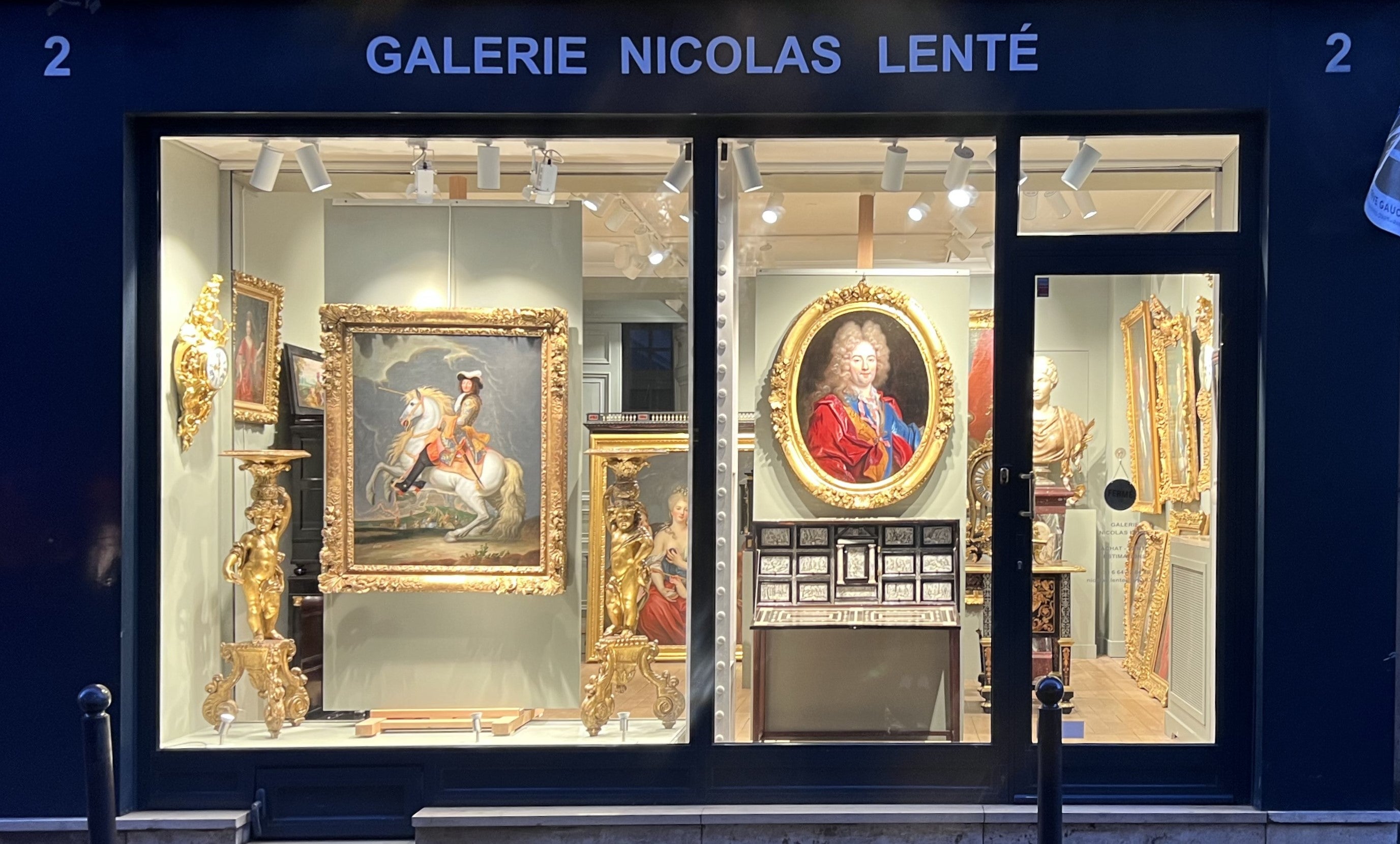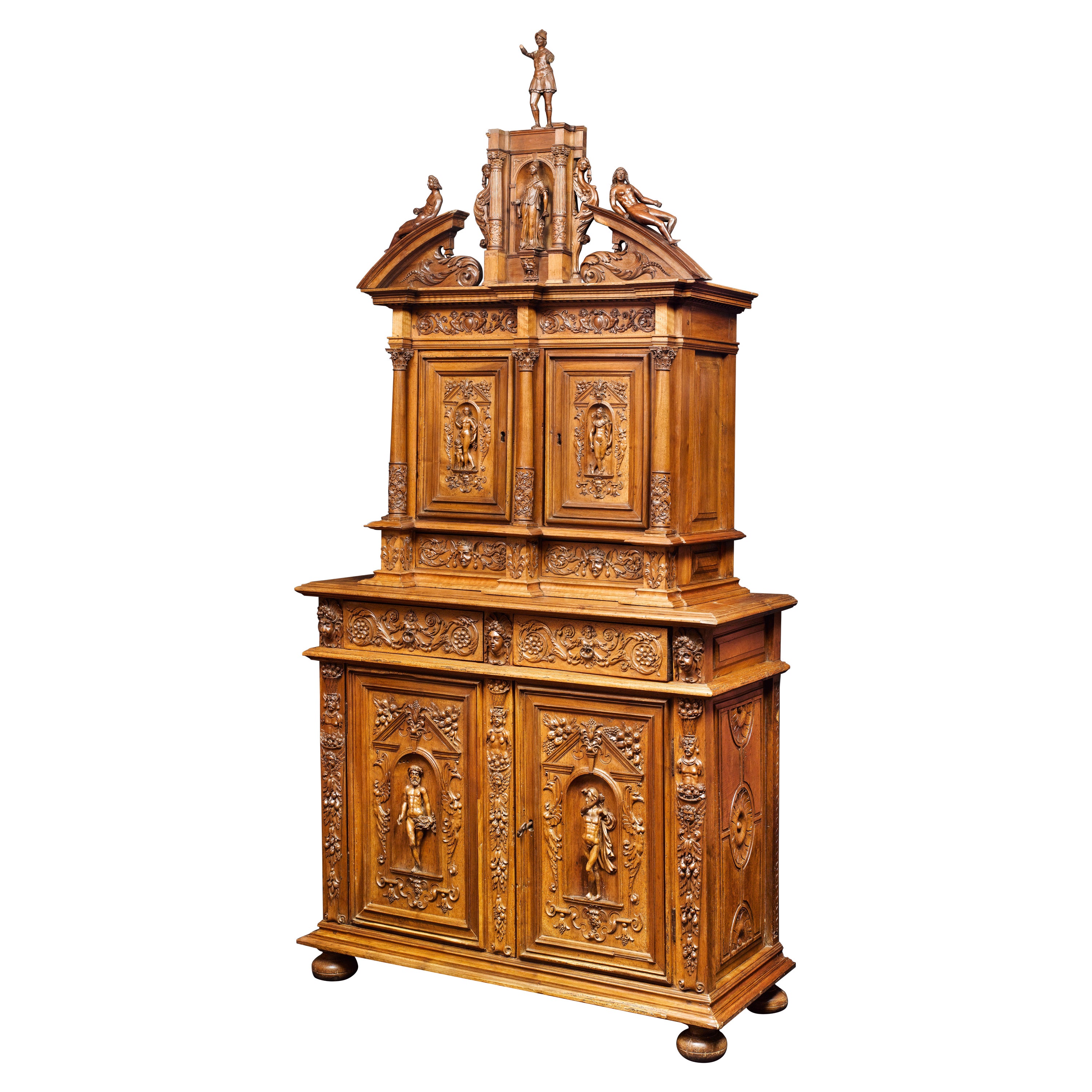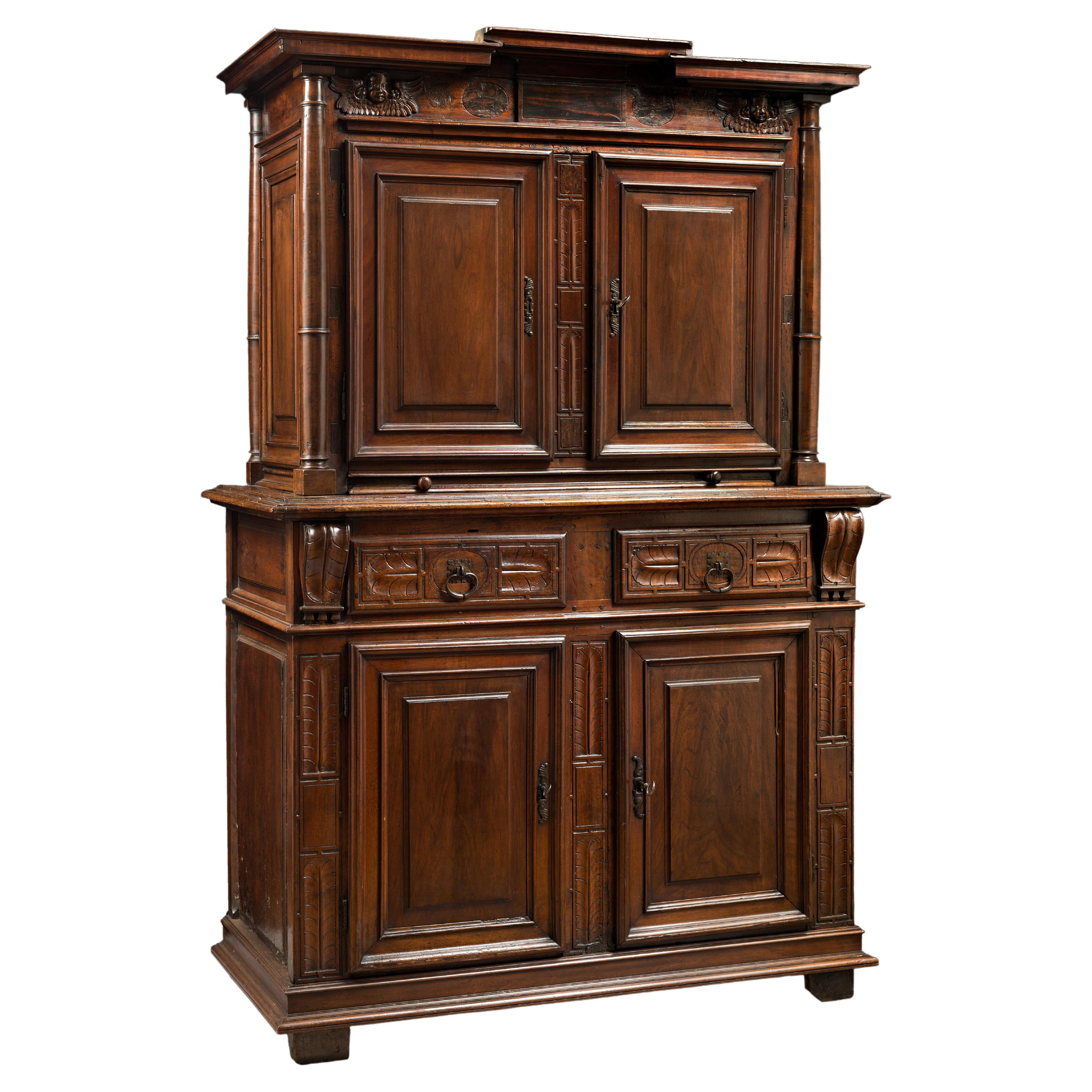Items Similar to A 16th Century Renaissance Cavred Walnut Buffet Loire Valley
Want more images or videos?
Request additional images or videos from the seller
1 of 8
A 16th Century Renaissance Cavred Walnut Buffet Loire Valley
About the Item
A 16th Century French Renaissance Cavred Walnut Buffet Loire Valley
Dimensions: H. 1m62; L. 1m02; P. 0.52m. (63.78 in. x 40.16 in x 20.47 in)
This two-body buffet has harmonious proportions associated with its small size. It opens with a set of two doors in the upper part as well as in lower part. Two drawers in the middle.
Of a very good quality of execution, this piece of furniture has for the ornamentation of the light wood nets encrusted in the framing of panels. Each door of the upper body is decorated with a vase welcoming a stylized bouquet made of mother-of-pearl inlays. As for the lower part of the buffet, the doors receive a geometric decoration made of wood inlays, tinted wood and walnut.
Beautiful state of conservation.
This kind of elegant hand carved furniture have been especially popular during Renaissance and made for castles in the Loire Valley during the 16th century.
- Dimensions:Height: 63.78 in (162.01 cm)Width: 40.16 in (102.01 cm)Depth: 20.47 in (52 cm)
- Materials and Techniques:
- Place of Origin:
- Period:
- Date of Manufacture:unknown
- Condition:Wear consistent with age and use.
- Seller Location:PARIS, FR
- Reference Number:1stDibs: LU8168237267722

About the Seller
No Reviews Yet
Vetted Seller
These experienced sellers undergo a comprehensive evaluation by our team of in-house experts.
Established in 2011
1stDibs seller since 2023
- ShippingRetrieving quote...Ships From: PARIS, France
- Return PolicyA return for this item may be initiated within 3 days of delivery.
More From This SellerView All
- A late 16th century French Renaissance richly carved walnut center tableLocated in PARIS, FRA late 16th century Renaissance richly carved walnut center table France, The Loire Valley area Dimensions: h. 33.46 in., w. 59.45 in., d. 36.22 in. Our remarquable table is a fabu...Category
Antique 16th Century French Renaissance Center Tables
MaterialsWalnut
- French 18th Century Regence Ormolu-Mounted Commode by Etienne DoiratBy Etienne DoiratLocated in PARIS, FRA Regence ormolu-mounted commode by Etienne Doirat (Paris, 1675-1732) Rare and elegant commode curved on the front and on the sides, in amaranth veneer arranged in sheets in the frames. It opens with four drawers in three rows: two large and two short and asymmetrical . Rich ornamentation of chiseled and gilt bronzes: the Rococo frontal cartouche, mounts with oak leaf windings, foliated handles and clogs, rosettes on the sides. Flanders red marble top. Size: h. 35.04 inch, w. 56.69 inch, d. 33.46 inch By Etienne Doirat (1675-25 June 1732), Regency period, 18th century Although not stamped, our commode belongs by its shape and its bronze ornamentations to an identified corpus of the production of Etienne Doirat, one of the most talented cabinetmakers under the Regency. This group of chests of drawers listed in public and private collections, some of which stamped E. Doirat are characterized by the almost identical front cartouche. On our chest of drawers, this cartouche is formed by two scalloped lambrequins joined by a clip they are extended by branches with acanthus foliage and flowers with beaded friezes. Inside are two keyholes, the first with a lion's mouth, the second formed by two stylized dolphins facing each other with lion's paws under a valance. Chests of drawers by Etienne Doirat with the frontal cartouche: Commode in identical "tombeau" shape: - Commode stamped Doirat, Christie's London, July 10, 2008 lot n 43 - Unstamped chest of drawers, doc. Me Tajan, published in "French 18th century Furniture" by Kjelleberg Commode of different shape, identical front cartouche: - Chest of drawers with three drawers, stamped Doirat, Christie's London, November 27, 2018 lot n 509 - Sarcophagus chest of drawers, stamped Doirat, J. Paul Getty museum, Los Angeles - Chest of drawers with two drawers, stamped Doirat, private collection, illustrated in J. - D. Augarde - Chest of drawers with three drawers, stamped by Migeon, but attributed to Doirat from the former Eugène Kraemer collection, sale at Galerie Georges Petit (Paris), May 5-6, 1913, lot 141; former Ogden Mills collection, Paris, rue de Varenne...Category
Antique Early 18th Century French Régence Commodes and Chests of Drawers
MaterialsMarble, Bronze
- Italian 19th century pair of very tall decorative marble obelisksLocated in PARIS, FRMonumental pair of obelisks veneered with following marbles: pink marble of the Pyrenees, blue Turquin and yellow of Siena. A very decorative pair of tall obelisks that would look g...Category
Antique Late 19th Century Italian Neoclassical Pedestals and Columns
MaterialsMarble, Siena Marble
- Early 18th Century Italian Carved Giltwood Mirror Depicting Four SeasonsLocated in PARIS, FREarly 18th century richly and profusely carved giltwood mirror depicting personnified allegories of the four seasons. The giltwood frame is made of adjourned wood decorated with flowers and leaves forming acanthus leaves spandrels. The pediment is lavishly carved and adorned with scrolls, foliage and flowers. Four putti...Category
Antique Early 18th Century Italian Louis XIV Wall Mirrors
MaterialsGiltwood
- 18th Century Gilt Bronze Boulle Marquetry Ormolu-Mounted Bracket ClockLocated in PARIS, FRA regence boulle marquetry ormolu-mounted bracket clock Our violin-shaped cartel is decorated with a marquetry Boulle with engraved brass decorated with windings, florets, cartridge...Category
Antique Early 18th Century French Régence Wall Clocks
MaterialsBronze
- 17th Century Antwerp Cabinet with Painted Panels Attributed to H. Van BalenLocated in PARIS, FRThis precious cabinet is one of the rare emblematic works of the city of Antwerp, produced in 17th century thanks to the collaboration between a painter and a cabinetmaker, and intended to adorn Kunstkammer (private museums) or art cabinets. Our cabinet is decorated with 13 oil painted panels featuring mythological and allegorical subjects and perfectly reflects the Antwerp pictorial trend of the early 17th century. Definitely in the spirit of the times, where one of the roles of the kunstkammer (the room for which it is intended) is to be able to contemplate the world in all its aspects. It opens with two doors revealing 10 drawers, 9 of which have painted panels on the front, a central door and an upper compartment, the interior of which is also decorated with a painted panel. The left door depicts a subject from Roman mythology: Pomona and Vertumnus in the garden. The fruits and vegetables placed at the feet of Pomona evoke the allegory of summer and the abundance of nature. While on the right door, under the airs of Venus and Love...Category
Antique Early 17th Century Belgian Louis XIII Cabinets
MaterialsWood, Paint
You May Also Like
- Renaissance Cupboard from Loire Valley, 'France'Located in Saint-Ouen, FRThis cabinet is composed of two bodies, the upper one being recessed. The extraordinary proportions are enriched by a mythological and floral carved decor. The Lower body stands o...Category
Antique 16th Century French Renaissance Cabinets
MaterialsWalnut
- French late 16th century Renaissance Walnut Deux-Corps cabinetLocated in Troy, NYBeautiful French Renaissance cabinet in two parts. The top part with two carved doors featuring classical figures opening to an interior fit...Category
Antique 16th Century French Renaissance Cabinets
MaterialsWalnut
- 16th Century Renaissance Two-Bodied CabinetLocated in Saint-Ouen, FRFormer collection Altounian At the beginning of the reign of Henri II (1547-1559) the furniture’s ornamentation evolves. The few medieval motifs that were still used are eventually relinquished. Furniture becomes more sober showcasing moulded panels and perfect architecture. Cabinet-makers use ornaments such as curved fluted or plain columns, feather quills, roses or winged putti heads. High-relief carving becomes more scarce and compositions lighter. To that end cabinet-makers draw inspiration from Fontainebleau motifs filtering them and adapting them to French taste. During this period cabinet-makers turn into a kind of architects. Indeed the architectural balance of furniture is the centre of their concerns. The study of Antic formulas is then a necessity. From this care given to proportions appear refined cabinets with pure lines. This style is characteristic of the reign of Henri II and disappears soon after under the regency of Catherine de Medici (1560-1574) when an abundance of high and low-relief ornaments comes back on furnitures. This two-bodies cabinet...Category
Antique 16th Century French Renaissance Cabinets
MaterialsWalnut
- 16th Century French Carved Renaissance CabinetLocated in Saint-Ouen, FRRare carved Renaissance cabinet Period : 2nd half 16th century, ca. 1570 Origin : France, Burgundy or Languedoc This cabinet embody the produ...Category
Antique 16th Century French Renaissance Cabinets
MaterialsWalnut
- French Renaissance Henry II Late 16th Century Walnut Deux-Corps CabinetLocated in Troy, NYFrench Henry II Deux-Corps cabinet, in two parts. Of linear design and interesting, unusual proportions, the top part with two-doors over two drawers, bottom with two larger drawers ...Category
Antique 16th Century French Renaissance Cabinets
MaterialsWalnut
- French 1750s Louis XV Walnut Floral Buffet à Deux-Corps from the Loire ValleyLocated in Atlanta, GAA French Louis XV period mid-18th century walnut buffet à deux-corps from the Loire Valley with bonnet top. Born in the exquisite Loire Valley region that shelters some of the most a...Category
Antique Mid-18th Century French Louis XV Buffets
MaterialsWalnut
Recently Viewed
View AllMore Ways To Browse
16th Century Oak Cupboard
Clothes Organizer
Jacobean Court
Two Jelly Cupboard
Welsh Cupboard Hutch
Breton Cupboard Armoire
Floral Painted Cupboard
Mid Century Larder
Log Cabin Sideboard
Lower Corner Cupboard Kitchen Counter
White Housekeeper Cupboard
Yoma Console
Top Cupboard
Large Case Pieces And Storage Cupboards
English Oak Cupboards
Solid Oak Kitchen Cupboard
Swedish Rustic Cabinet
Antique Spanish Colonial Doors





